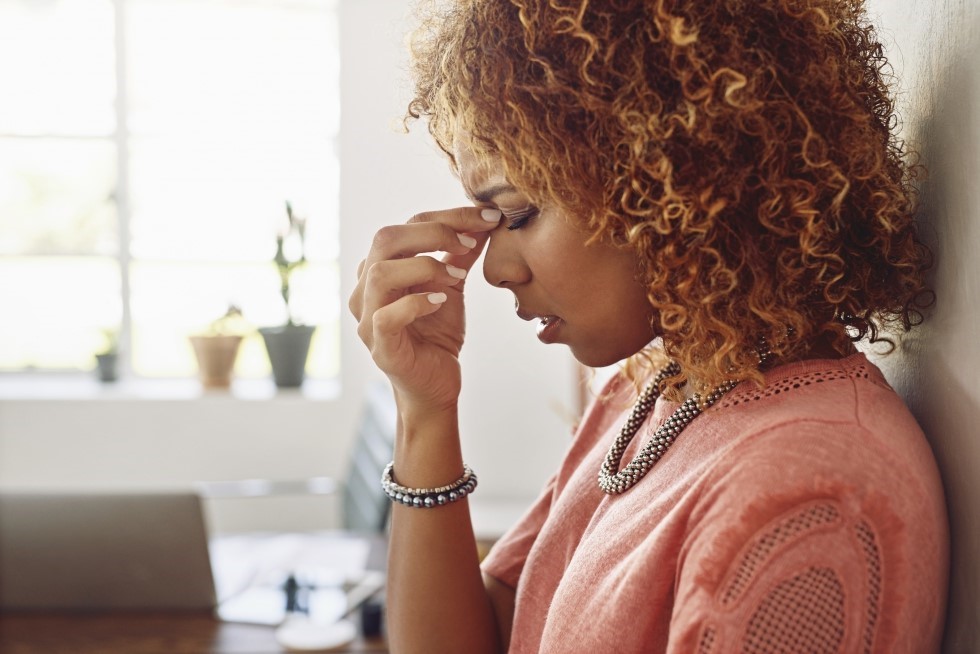Senior Clinical Nurse Specialist Rachel Rawson explains how to spot the signs of anxiety, and explains some simple ways of coping and reducing it.
Senior Clinical Nurse Specialist Rachel Rawson explains how to spot the signs of anxiety, and explains some simple ways of coping and reducing it.

Photo: istock.com/PeopleImages
Anxiety is a normal human experience that many people live with. But when it becomes very strong or lasts for a long time it can be overwhelming. After breast cancer it’s not unusual for anxiety to get worse or to appear for the first time. It can leave you with a sense of worry or dread – where hours can be spent thinking over worst-case scenarios – and gets in the way of daily life.
We look at tips for overcoming anxiety, understanding anxiety, and recognising the signs.
10 ways to help reduce anxiety
- Talk it through
- Take a deep breath
- Write a diary
- Practise yoga and mindfulness
- Keep fit
- Remember it will pass
- Break it down into smaller tasks
- Try Becca, our free app
- Talking therapy
- Medication
1. Talk it through

Talking about what triggers anxiety with a friend or partner – someone who knows you well and you can trust – can help.
Talking to someone away from the home environment can also help. Speaking to a breast care nurse, calling Breast Cancer Now’s Helpline, posting on the online Forum or joining a support group can be useful ways of knowing you’re not alone.
2. Take a deep breath
Breathing more deeply can make you feel a lot calmer.
Breathe in through your nose and out through your mouth. Try to keep your shoulders down and relaxed, and place your hand on your stomach – it should rise as you breathe in and fall as you breathe out.
3. Write a diary

Keeping a diary can help you see how you’re feeling day to day as well as what helps or triggers stress and anxiety.
4. Practise yoga and mindfulness

Yoga and mindfulness may help you relax, sleep better and manage the symptoms of anxiety and panic attacks. There are lots of mindfulness apps available, some of which, like Smiling Mind, are free.
If you're starting out, these beginner yoga tips may help.
5. Keep fit
Exercise can help you manage anxiety and panic attacks.
Thinking about exercising can be overwhelming, but just going for a short walk every day can give you some time to yourself. There are lots of different types of exercise. The important thing is to find something you enjoy.
6. Remember it will pass

Reassure yourself that the symptoms you’re experiencing are caused by anxiety and will pass. This can help you feel calmer and less fearful of future bouts of anxiety.
7. Break it down into smaller tasks
Big tasks can feel impossible, but breaking them down into smaller tasks can make them feel easier to complete.
8. Try Becca, our free app
The need for support doesn't end when treatment does, and one in four women experience anxiety at this point. If you've finished treatment, try Becca, the free Breast Cancer Now app. It gives you information, support and inspiration to help you move beyond breast cancer, presented on easy-to-use flashcards.
9. Talking therapy
Talking therapies, such as cognitive behavioural therapy (CBT), are becoming more widely available. CBT focuses on changing the way you think and behave and teaches coping skills for dealing with different problems. Having access to counselling or therapy may also be useful. A trained therapist will work with you to understand the causes of your anxiety, and to find strategies to help manage it.
10. Medication
Certain types of medication can be helpful and these can be used in addition to other self-help strategies. Antidepressants and beta-blockers are two of the most commonly used medications.
When the bucket overflows
Being diagnosed with breast cancer, having treatment, dealing with side effects, then learning to find your new normal is stressful. While having a degree of stress in life is fine, when it builds up it can lead to anxiety, which can be hard to cope with on a daily basis.
The charity Anxiety UK has a useful way to think about stress and anxiety. Imagine that stress levels are like water in a bucket. If stressors are added to the bucket, even tiny ones like the school run or commuting to work, over time the buckets fills up. Then one day, often after what seems like a trivial trigger, it overflows.
At times like this the simple things in life can seem overwhelming, and the physical and psychological symptoms that anxiety brings can be difficult to understand and cope with.
Finding a way to have a bucket with holes in the bottom can, in the long term, reduce overall stress levels and anxiety. Each one of these holes could be something positive that’s done to manage anxiety.
Recognise the signs
Physical feelings of anxiety can include a racing heart, light-headedness, headaches, churning in the pit of the stomach and, for some people, panic attacks.
The psychological signs of anxiety can be harder to identify. Experiencing a sense of dread or numbness, the mind racing, restlessness, not being able to concentrate and fearing the worst are all symptoms of anxiety.
Recognising these signs and symptoms can sometimes be difficult and seeking help and support is often the hardest thing to do. But taking this first step can be the key to breaking the cycle of feeling fearful and insecure.
Useful resources
- Mind provides information and support to anyone with anxiety or other mental health issues.
- Anxiety UK works to relieve and support people living with anxiety and anxiety-based depression.
- Smiling Mind is a free guided meditation app that can help with anxiety.
Content created March 2017; updated March 2020